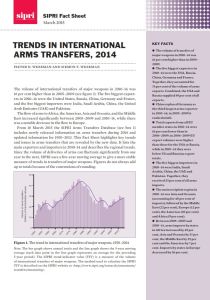Join getAbstract to access the summary!

Join getAbstract to access the summary!
Siemon T. Wezeman and Pieter D. Wezeman
Trends in International Arms Transfers, 2014
Stockholm International Peace Research Institute, 2015
What's inside?
The Stockholm International Peace Research Institute examines trends in international arms trading from 2009 to 2013.
Recommendation
In recent years, many countries have actively engaged in the development and exchange of major weapons. Reporting for the Stockholm International Peace Research Institute (SIPRI), authors Siemon T. Wezeman and Pieter D. Wezeman reveal trends in the arms industry and list the major exporters and importers of arms between 2009 and 2013. Although they provide sufficient numerical data, the SIPRI report stops short of explaining the implications of these trends for international relations and global peace. Always politically neutral, getAbstract recommends this fact sheet to policymakers, peace activists and those who take particular interest in international relations.
Summary
About the Authors
Pieter D. Wezeman and Siemon T. Wezeman are senior researchers with the Stockholm International Peace Research Institution (SIPRI) Arms Transfers Programme.

















Comment on this summary